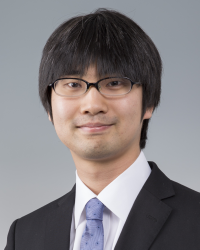| Award Ceremony/Acceptance Speech | 10/27 17:30-19:00 | ||
| ▼Acceptance Speech | Ibuki Kawamata (Kyoto University) | ||
| "Development of Molecular Robots Integrating Biomolecular Devices" | |||
A molecular robot is a system that integrates devices where each of the components of robots, such as sensors, processors, and actuators are implemented using biomolecules [1]. Molecular robots are a type of smart material that can change its shape or release molecules depending on the environment and are expected to find a variety of applications in medicine and other fields thanks to their biocompatibility.
The main biomaterials that constitute molecular robots are nucleic acids, proteins, lipids, and polymer gels, while nano to micro-sized systems that appropriately combine these materials have been devised. To develop molecular robots with the expected functions, it is not enough to simply assemble the materials made of biomolecules, whereas it is necessary to design the interactions between molecular devices without deficiency. In other words, we need to program the interaction of biomolecules, and thus molecular dynamics simulations and chemical reaction simulations are harnessed to support the design, meaning that the field of molecular robotics is truly interdisciplinary that requires the expertise of Biochemistry, Robotics, and Information science.
In this talk, I will introduce our molecular robots, especially devices where the interactions of DNA molecules are programmed. For example, I will introduce a deformable device fabricated using DNA origami [2], a technology to build precise nano-scale structures, and describe its application toward cultured cancer cells [3-4]. I will also introduce recent research on the control of microtubule motion using DNA computer technology, in which calculations are performed by molecules [5].
[1] S. Murata, A. Konagaya, S. Kobayashi, H. Saito, M. Hagiya, Molecular Robotics: A New Paradigm for Artifacts. New Generation Computing, 31, 2013
[2] 川又生吹, 鈴木勇輝, 村田智, DNA origami入門 基礎から学ぶDNAナノ構造体の設計技法, オーム社, ISBN 978-4-274-22713-4, 2021
[3] D. Karna, E. Mano, J. Ji, I. Kawamata*, Y. Suzuki*, H. Mao*, Long-range Chemo-mechanical Force Modulates Higher Order Mesoscale Biostructures, Nature Communications, 14, 2023
[4] D. Karna, S. Watanabe, G. Sharma, A. Sharma, Y. Zheng, I. Kawamata, Y. Suzuki*, H. Mao*, Logic-Gated Modulation of Cell Migration via Mesoscale Mechanical Uncaging Effects, ACS Nano, 19, 2025
[5] I. Kawamata, K. Nishiyama, D. Matsumoto, S. Ichiseki, J. J. Keya, K. Okuyama, M. Ichikawa, A. M. R. Kabir, Y. Sato, D. Inoue, S. Murata, K. Sada, A. Kakugo, S. M. Nomura, Autonomous assembly and disassembly of gliding molecular robots regulated by a DNA-based molecular controller, Science Advances, 10, 2024
